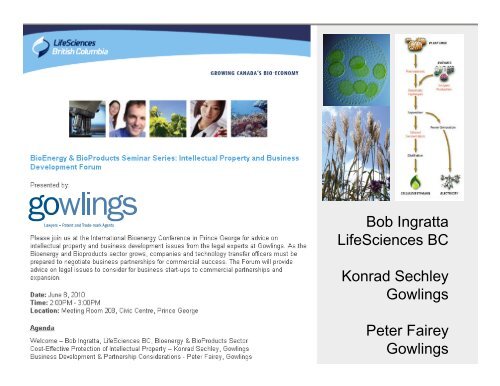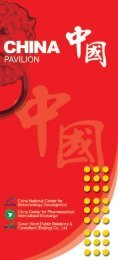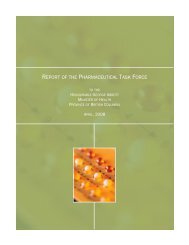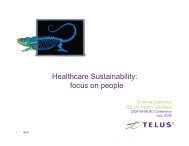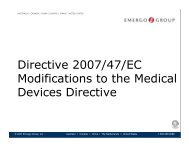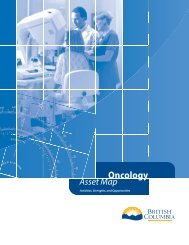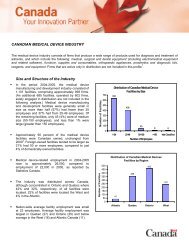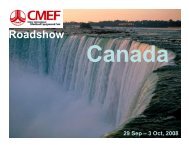Bob Ingratta LifeSciences BC Konrad Sechley Gowlings Peter ...
Bob Ingratta LifeSciences BC Konrad Sechley Gowlings Peter ...
Bob Ingratta LifeSciences BC Konrad Sechley Gowlings Peter ...
You also want an ePaper? Increase the reach of your titles
YUMPU automatically turns print PDFs into web optimized ePapers that Google loves.
<strong>Bob</strong> <strong>Ingratta</strong><br />
<strong>LifeSciences</strong> <strong>BC</strong><br />
<strong>Konrad</strong> <strong>Sechley</strong><br />
<strong>Gowlings</strong><br />
<strong>Peter</strong> Fairey<br />
<strong>Gowlings</strong><br />
1
The <strong>Gowlings</strong> Edge…<br />
Full Service Law Firm<br />
Offices across Canada, London England, and Moscow<br />
>700 legal professionals<br />
Extensive depth in:<br />
Litigation - IP and other<br />
Employment advice<br />
Tax advice<br />
Government Relations advice<br />
Commercialization<br />
Advertising marketing<br />
Product liability advice<br />
M&A advice<br />
Largest IP group in Canada<br />
2
Managing Intellectual Property<br />
Patent Prosecution Firm of the Year<br />
(2006-2010)<br />
Trade-mark Prosecution Firm of the<br />
Year (2006-2009)<br />
Patent Case of the Year (2009)<br />
Copyright Case of the Year (2009-2010)<br />
3
Life Sciences<br />
Cost Effective Protection of Intellectual Property<br />
innovation <strong>Konrad</strong> <strong>Sechley</strong> PhD<br />
starts
Overview<br />
Introduction<br />
Bioenergy IP trends<br />
Presentation Topic here<br />
Review of proper patent practices<br />
Filing strategies<br />
Tips for reducing costs<br />
5
Why Care About Intellectual Property?<br />
Intellectual Property Rights<br />
= Competitive Advantage<br />
6
What is Intellectual Property?<br />
Assorted rights to exclude others<br />
National in scope<br />
Harmonization through international treaties:<br />
- Patent Cooperation Treaty (global filing treaty)<br />
- Paris Convention (priority right treaty)<br />
7
Types of Intellectual Property<br />
•Patents<br />
• Trademarks<br />
•Copyright<br />
• Industrial Designs<br />
• Integrated Circuit<br />
Topography<br />
• Plant Breeders’ Rights<br />
• Trade Secrets<br />
8
Purpose of the patent system<br />
Applicant:<br />
obtains monopoly to exploit invention for set period<br />
- in most countries 20 years from date of filing<br />
- rights enforceable after patent is granted<br />
Public:<br />
obtains access to information to work invention<br />
- applications typically published after 18 months<br />
9
Why Patent?<br />
Competitive Advantage<br />
Blocking patents<br />
Royalty Stream<br />
Attract Investment<br />
Negotiation – cross license<br />
10
Cons<br />
Expense<br />
- National protection<br />
- Publication – after 18 months<br />
- US may request non-publication*<br />
Definite term – typically 20 years from filing date<br />
Patent does not provide right to practice<br />
- freedom to operate<br />
- regulatory approval<br />
*conditions apply<br />
11
National protection<br />
A patent is only valid in the country within which<br />
it is issued<br />
- each country administers it own patents:<br />
Canadian Intellectual Property Office (CIPO)<br />
US Patent and Trademark Office (USPTO)<br />
European Patent Office (EPO) + each country<br />
Japanese Patent Office (JPO)<br />
etc…<br />
12
Alternatives to Patenting<br />
Trade secrets<br />
- indefinite term<br />
- efforts must be made to keep know-how secret<br />
Publication<br />
- can be used effectively<br />
Petty or innovation patent<br />
- only in certain countries; weaker protection<br />
Trend to “open innovation”<br />
13
Open Innovation<br />
Standards - FRAND<br />
Patent pool<br />
Patent commons<br />
Open source<br />
14
Eco-Patent Commons<br />
“…unleashing dozens of innovative, environmentally responsible patents to the public<br />
domain”<br />
“Availability of these patents will encourage researchers, entrepreneurs and companies<br />
of all sizes in any industry to create, apply and further develop their consumer or<br />
industrial products processes and services in a way that will help to protect and respect<br />
the environment.”<br />
17
• Patents have an<br />
environmental benefit<br />
• Patents are pledged<br />
• To become a member<br />
must pledge a patent<br />
• If remove patent, no<br />
longer a member<br />
• Patents are not dedicated<br />
to public – can be asserted if required<br />
18
Common elements to open access schemes<br />
Involve patents<br />
- to enforce rights against abuse by others<br />
Provide access to collection of patent rights<br />
- management of IP collection required<br />
- agreements, licenses<br />
- some situations require valuation of IP<br />
Need to ensure non-competitive behaviour<br />
- independent third part expert review may be required<br />
Incentive to join - needs to be < cost of not joining<br />
- need to capture key IP<br />
19
Published patent applications and patents<br />
23
Nature Biotech 24: 643-651 June 2006<br />
24
USPTO – Allowance Rate June 2009<br />
USPTO Allowance rate 1975-2009<br />
25
Increase in US allowance rate – will the trend hold?<br />
26
Requirements for Patent<br />
Statutory Subject Matter<br />
Novelty<br />
Inventive Step (non-obviousness)<br />
Utility<br />
27
Statutory Subject-Matter<br />
CA EP US<br />
• an idea X X X<br />
• a method of doing business X X ~Y<br />
• abstract theorems X X X<br />
• computer program ~Y ~Y ~Y<br />
• methods of medical treatment X X Y<br />
• medical use Y Y N<br />
• higher life forms X* Y Y<br />
28
Utility<br />
Real world, specific, credible utility<br />
described in the Patent Application<br />
No patents for inventions that defy scientific<br />
principles (e.g. perpetual motion)<br />
29
New in view of any public disclosure before<br />
application filed<br />
- Single disclosure<br />
Novelty:<br />
Invention<br />
A + B + C<br />
A + B + C<br />
A + B + C<br />
Prior disclosure<br />
A + B<br />
A + B + D<br />
A + B + C<br />
New?<br />
Yes<br />
Yes<br />
No<br />
30
Inventive Step:<br />
Not obvious in view of any public disclosure<br />
before application filed<br />
Multiple disclosures can be considered<br />
Invention<br />
Disclosure 1<br />
Disclosure 2<br />
Inventive?<br />
A + B + C<br />
A + B<br />
B + D<br />
Yes<br />
A + B + C<br />
A + B<br />
B + C<br />
Yes<br />
Not obvious combine 1 + 2<br />
A + B + C<br />
A + B<br />
B + C<br />
No<br />
Obvious combine 1 + 2<br />
31
Public Disclosure (Prior Art)<br />
Made available to public by:<br />
Publication<br />
Public use<br />
Sale/offer to sell (US)<br />
Oral disclosure (conference proceeding; thesis defense)<br />
Grant applications (e.g. NSERC, CIHR, DOE etc)<br />
Internet postings<br />
Disclosure must be:<br />
Non-confidential<br />
Enabling<br />
Grace period in some countries<br />
32
Patent Application<br />
Description<br />
Fully describe invention including drawings<br />
Best mode (US; & machines for Canada)<br />
Full description needed for priority<br />
Avoid quick and dirty provisionals<br />
Claims<br />
Give scope of protection<br />
Can be for a method, apparatus, product<br />
Series of numbered paragraphs<br />
- independent claims gives broadest protection<br />
- dependent claims give progressively narrower protection<br />
33
You have an invention – now what?<br />
Comprehensive invention disclosure<br />
Maintain confidentiality<br />
Conduct a patent search (in-house/externally)<br />
Patentability opinion – may be oral or written<br />
Draft proper application<br />
- use patent agent to draft application<br />
Determine inventorship<br />
Check employment/contactor agreements<br />
Obtain executed assignments early<br />
- include language to execute future documents<br />
If done properly will decrease future costs significantly<br />
34
Maintaining Confidentiality<br />
Avoid publicly disclosing your invention<br />
Consider Non Disclosure Agreements (NDAs)<br />
- if NDA not an option then file application first<br />
If prior public disclosure is unavoidable, grace<br />
periods are available in some countries<br />
35
Who is an inventor?<br />
Person who “conceives” invention<br />
- complete performance of the mental part of<br />
the inventive act<br />
- not just desired result<br />
- means to achieve result must be provided<br />
Determined by what is claimed<br />
- inventorship may change during prosecution<br />
Can have multiple inventors<br />
36
Who is not an inventor?<br />
Person provides:<br />
- routine technical contribution<br />
- moral or financial support<br />
- general idea of desired result stimulated<br />
research<br />
Different from authorship<br />
37
Determining inventorship is important<br />
Patents have been invalidated by having<br />
incorrectly named inventors<br />
Potential infringers have avoided infringement by:<br />
- licensing rights from non-listed inventors, and<br />
- amending inventorship at a latter date in court<br />
38
Ownership<br />
Co-owner’s rights without consent of other co-owner:<br />
- work invention<br />
- assign (Canada v. US)<br />
- licence invention – US only<br />
Employer’s rights<br />
Inventor owns patent rights – except:<br />
- express contract that employer owns rights<br />
- employee hired for expressed purpose to invent<br />
39
Where and when to file?<br />
What to file?<br />
Initial<br />
filing date<br />
Options at one<br />
year anniversary<br />
•File in CA, US, EP etc<br />
•File International (PCT) application<br />
•File in non-PCT countries<br />
Upgrade application<br />
•File in CA, US, EP etc<br />
PCT national phase 30 months from<br />
Initial filing date<br />
40
US Provisional, CA informal filing - advantages<br />
Can be done at the last minute<br />
- scientific paper/poster presentation (with upgrading)<br />
- do not file grant proposal<br />
- refile with complete application ASAP<br />
Reduced paper work after filing<br />
Can evaluate technology during priority year to see<br />
if application to be retained<br />
Can obtain an extra year from filing date<br />
- 21 year term<br />
US provisional not published<br />
CA informal will publish, but can be withdrawn<br />
41
Provisional, informal filing - problems<br />
Not a mechanism to reduce cost<br />
- application must be re-filed after one year<br />
Provisional may not qualify as priority application<br />
- must satisfy written description requirement<br />
(e.g. New RailHead US, #02-1028 July 30,2002)<br />
Need to ensure a “complete” application is filed<br />
- if file quick and dirty, refile complete application ASAP<br />
May delay examination by year<br />
Reduced paperwork<br />
- recommend getting assignments filed<br />
42
Commercialization Considerations<br />
Where to file priority application?<br />
- US provisional or regular<br />
- market/investor needs<br />
- Canada informal or regular<br />
- cost effective,<br />
- can accelerate examination<br />
- can use Patent Prosecution Highway<br />
-UK<br />
- can request early search<br />
-PCT<br />
- no further data to be added<br />
- if prior art an issue (one year grace period)<br />
43
Patent Cooperation Treaty<br />
PCT application<br />
- reserve right to file in over 140 countries<br />
Can claim priority (Paris Convention)<br />
Can delay procedure before National Offices<br />
- up to 20 or 30 months from earliest priority date<br />
- advantage: delays filing costs from 12-30 months<br />
- disadvantage: delays examination by up to 2.5 years<br />
2 phases:<br />
International phase<br />
National phase<br />
44
Patent Cooperation Treaty<br />
International phase - Chapter I<br />
- application searched<br />
- search report and application published at 18 months<br />
- preliminary examination provided<br />
- claims can be amended<br />
Can enter National Phase at any time<br />
Can delay entry up to 30 months in most countries<br />
- determine markets where application needs to be filed<br />
- obtain commercialization partners<br />
- if search report negative, can drop application<br />
45
Patent Cooperation Treaty<br />
Chapter II – must be requested<br />
Extends proceedings to 30 months in some countries<br />
Examination carried out by Canadian Office<br />
Applicant may respond to preliminary examination<br />
Final examination report published (IPRP)<br />
Examination helpful in deciding further filing strategy<br />
May enter National phase any time during PCT<br />
46
Where and when to file?<br />
Initial<br />
filing date<br />
Options at one<br />
year anniversary<br />
•File in CA, US, EP etc<br />
•File International (PCT) application<br />
•File in non-PCT countries<br />
Upgrade application<br />
•File in CA, US, EP etc<br />
PCT national phase 30 months from<br />
Initial filing date<br />
47
Considerations<br />
Market size<br />
Cost<br />
Manufacture<br />
- will invention be worked in country?<br />
Sales presence<br />
- can you monitor potential infringers?<br />
Competitors<br />
48
Controlling prosecution costs<br />
Technologies with significant prior art:<br />
- invention more difficult to argue<br />
- costs increase<br />
- claims scope is narrow<br />
- strength of claim increases<br />
Provide timely instructions<br />
Provide input regarding inventive step<br />
- Examiner interviews<br />
Evaluate portfolio regularly<br />
- license or abandon as needed<br />
49
Top tips for reducing costs<br />
1. Determine FTO early - design research program<br />
2. Comprehensive invention disclosure<br />
3. In-house patent searches<br />
4. Oral patentablity opinion<br />
5. Draft proper application (will save costs downstream)<br />
6. Address inventorship & ownership issues early<br />
7. File strategically<br />
8. Use cost reducing options effectively (PCT, EPO)<br />
9. Good communication with your patent agent<br />
10.Re-evaluate your patent portfolio regularly<br />
50
Thank You<br />
<strong>Konrad</strong> <strong>Sechley</strong> PhD<br />
Gowling Lafleur Henderson LLP<br />
Vancouver, <strong>BC</strong><br />
604-443-7610<br />
konrad.sechley@gowlings.com<br />
montréal ottawa toronto<br />
hamilton waterloo region calgary vancouver moscow london


